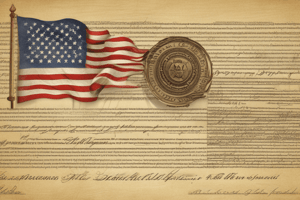Podcast
Questions and Answers
What was the main issue the delegates needed to resolve regarding state power?
What was the main issue the delegates needed to resolve regarding state power?
- How to create a national army
- How to select the President
- How much power each state would have (correct)
- How to fund the federal government
Which two plans were presented to address the representation of states in Congress?
Which two plans were presented to address the representation of states in Congress?
- The Virginia Plan and New Jersey Plan (correct)
- The Great Compromise and New Jersey Plan
- The Delaware Plan and Virginia Plan
- The Virginia Plan and Maryland Plan
What is the structure of Congress as established by the Great Compromise?
What is the structure of Congress as established by the Great Compromise?
- A bicameral legislature with a Senate and House of Representatives (correct)
- A unicameral legislature that allows states more influence
- A bicameral legislature with equal representation in both houses
- A unicameral legislature based on national population
How are representatives allocated in the House of Representatives according to the Great Compromise?
How are representatives allocated in the House of Representatives according to the Great Compromise?
What was necessary for the Constitution to become law?
What was necessary for the Constitution to become law?
Which state was the first to ratify the Constitution?
Which state was the first to ratify the Constitution?
What concern did some individuals have regarding the Constitution?
What concern did some individuals have regarding the Constitution?
Who were some influential figures that supported the Constitution?
Who were some influential figures that supported the Constitution?
Flashcards are hidden until you start studying
Study Notes
The Great Compromise
- Delegates disagreed on the role of state and national governments, particularly how much power each state should have.
- The Virginia Plan favored larger states by proposing a bicameral legislature with representation based on population in both houses.
- The New Jersey Plan favored smaller states, proposing a unicameral legislature with equal representation for each state.
- The Great Compromise, reached by the delegates, created a bicameral Congress with the Senate providing equal representation for each state and the House of Representatives allocating representation based on population.
Ratification
- The U.S. Constitution was signed by 39 delegates on September 17, 1787.
- The Constitution was ratified by nine of the thirteen states, becoming law.
- Delaware was the first state to ratify the Constitution.
- Some individuals opposed ratification due to concerns about surrendering too much power to the national government.
- Influential figures like Benjamin Franklin and George Washington advocated for ratification.
Studying That Suits You
Use AI to generate personalized quizzes and flashcards to suit your learning preferences.




